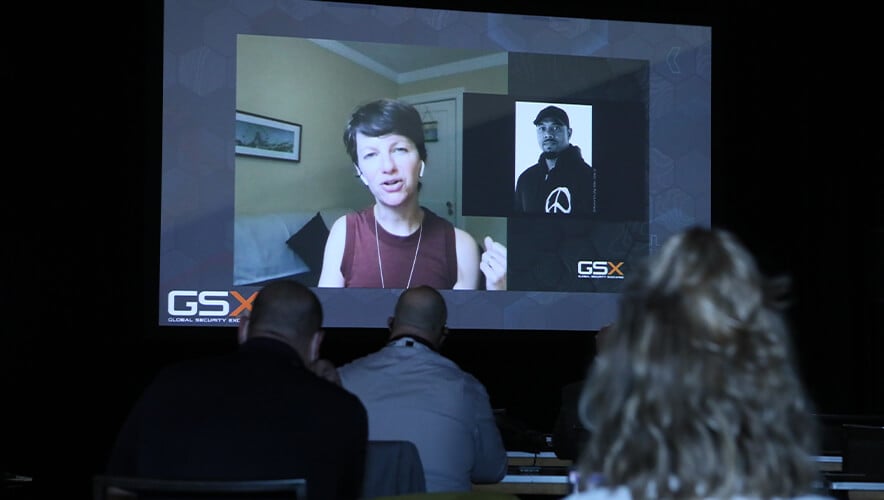We’re Trapped in Toxicity. Here’s How We Get Out.
Keynote speaker Amanda Ripley illustrated her take on toxic conflicts during the GSX 2021 general session on Tuesday, 28 September.
Ripley—whose latest book, High Conflict: Why We Get Trapped and How We Get Out, expands on this topic—noted that while “good conflict” can be beneficial, pushing people to improve themselves or their environments, “high conflict” is purely negative. She described “high conflict” as toxic, a seemingly unending cycle that sustains disagreements between parties.
“There are days when it can feel that we are trapped in conflict—in the news, in politics, in social media,” Ripley said. She added that she wanted to keep studying high conflict given her impression that lately, “no one seems to change their mind, regardless of what happens.”
“We’re much more likely in high conflict to engage in repeated cycles of violence and revenge,” she added. “Typically, in high conflict, everyone ends up worse off to different degrees.”
Typically, in high conflict, everyone ends up worse off to different degrees.
At its core, a high conflict is a kind of disagreement that occurs only for the sake of having a conflict. It is also characterized by emotions such as rigidity and a sense of righteousness from the people engaged within the conflict.
Ripley learned about high conflict—what leads to it and how to get out of it—by reviewing a variety of sources and interviewing individuals engaged in various types of high conflict, including political feuds, divorce courts, and gang violence.
She found that spotting high conflict can help someone avoid or altogether get out of the cycle of engaging in high conflict. Besides being able to identify a high conflict scenario, another way to avoid one is to understand and identify people, events, or emotions that can push people towards high conflict. Ripley called these triggers “firestarters.”
Although our brain prefers to categorize and determine patterns to make sense of the world around us, Ripley cautioned against subscribing to binary fixed groups that encourage a general thinking of “Us versus Them.”
“When we split the world this way it tends to bring out our worst conflict instincts,” she said. “This is true even in real time confrontations—if you’re trying to deescalate a potential crisis, you never want to put yourself squared off in opposition to the person in crisis. You want to stand a little off to the side.”
The same idea applies to interacting with groups in longer or more abstract conflicts. While pertaining to a group can offer various benefits, that sense of belonging can be turned against us and used to push us into a high conflict scenario.
And another firestarter that Ripley called “conflict entrepreneurs”— people or organizations who instigate conflict for their own ends—are very good at using group identities to stoke a conflict’s flames. Even media outlets can operate as conflict entrepreneurs, catering to what readers, listeners, and viewers want to believe.
To further escalate conflict, conflict entrepreneurs may seek to humiliate their opponent. Humiliation, a third firestarter, fundamentally threatens a core sense of someone’s identity and self-worth.
“Humiliation is the ‘nuclear bomb’ of the emotions,” Ripley said. “Humiliation jeopardizes our deepest part of ourselves, our sense that we matter, that we’re worth something. And people need to matter—it’s a fundamental requirement for human life. So, humiliation lies underneath all kinds of high conflict.”
Humiliation jeopardizes our deepest part of ourselves, our sense that we matter, that we're worth something.
While there are other firestarters—such as corrupt institutions—binary thinking, humiliation, and conflict entrepreneurs are lesser-known but iconic aspects of high conflict to watch out for. Armed with the understanding of what they are, security practitioners can identify firestarters and de-escalate situations into “good conflict” and away from high conflict.
For instance, Ripley recommended avoiding categorizing someone based on an individual disagreement and instead use active listening to build rapport. Then, once rapport is established, she suggested leveraging that rapport to obtain a desired outcome without falling into the toxic patterns of high conflict.
If you missed the Ripley’s session on Tuesday morning and want to learn more about how to extract from a high conflict scenario, you can still catch “Breaking the Spell of High Conflict” on the GSX platform.
Sara Mosqueda is assistant editor for Security Management, the parent publication of The GSX Daily. Connect with her at [email protected]. Follow her on Twitter: @XimenaWrites.
